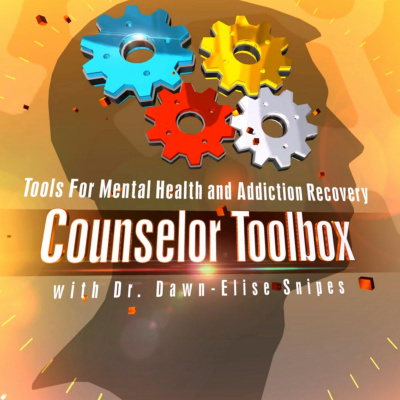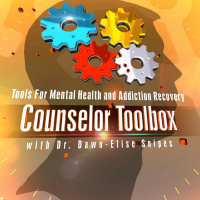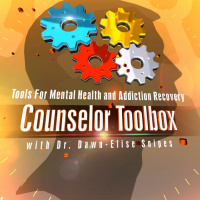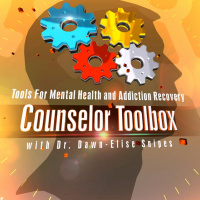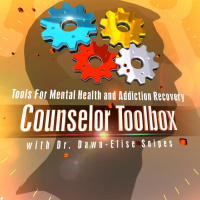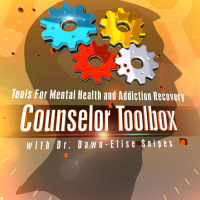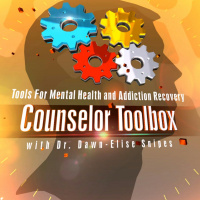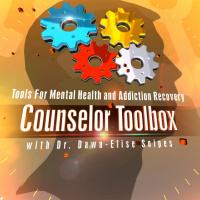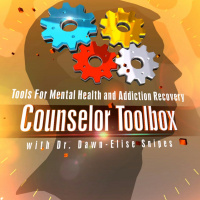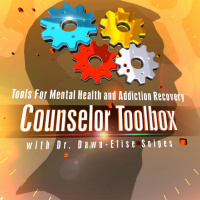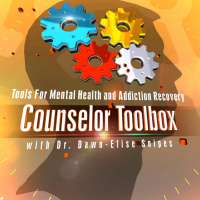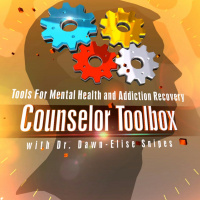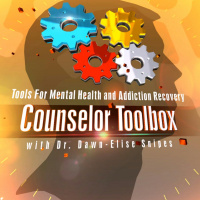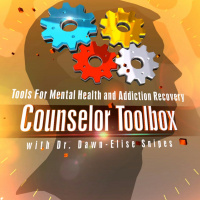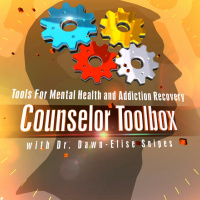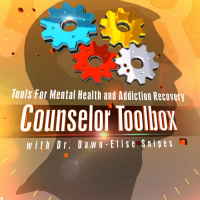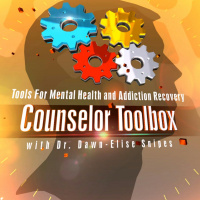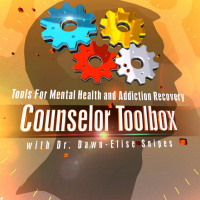Sinopsis
Counselors, coaches and sober companions help hundreds of thousands of people affected by Addictions and Mental Health issues each year. Learn about the current research and practical counseling tools to improve your skills and provide the best possible services. Counselor Toolbox targets counselors, coaches and companions, but can also provide useful counseling self-help tools for persons struggling with these issues and their loved ones. AllCEUs is an approved counseling continuing education provider for addiction and mental health counselors in most states. Counseling CEUs are available for each episode.
Episodios
-
1060-How Stress Alters Hormones, Neurotransmitters & Mental Health
22/04/2025 Duración: 02h54minI. Introduction to Stress and Its Impact Stress affects the body's hormonal and neurotransmitter systems. Chronic stress can lead to significant mental health challenges. II. Hormonal Responses to Stress Cortisol: Known as the "stress hormone," it increases in response to stress. Elevated cortisol levels can impair memory and cognitive functions. Adrenaline and Noradrenaline: These hormones prepare the body for "fight or flight" responses. Prolonged elevation can lead to anxiety and sleep disturbances. III. Neurotransmitter Alterations Serotonin: Chronic stress can decrease serotonin levels, contributing to depression. Dopamine: Stress can disrupt dopamine pathways, affecting motivation and pleasure. GABA: Reduced GABA activity under stress can lead to increased anxiety. IV. Mental Health Consequences Persistent stress is linked to disorders such as depression and anxiety. Stress can exacerbate symptoms in individuals with pre-existing mental health conditions. V. Strategies
-
1059-Overcoming the scars of ACEs and parental alienation
25/03/2025 Duración: 44minParental Alienation Defined Parental alienation is not abandonment or protecting a child from abuse; it is a form of psychological abuse. It involves a deliberate campaign of denigration, brainwashing, and manipulation of the child to reject the other parent. Alienating Behaviors Alienation occurs when one parent actively manipulates a child against the other parent, which can be unconscious or conscious. These behaviors involve brainwashing, manipulating, or lying to the child, often supported by family members or other influential figures in the child’s life. The Impact on Children Parental alienation disrupts children’s primary attachment bonds, causing deep psychological harm. Children may develop symptoms like Stockholm syndrome, where they begin to rationalize the alienating parent’s behavior and vilify the targeted parent. Alienation as an Adverse Childhood Experience (ACE) Parental alienation is considered psychological abuse, one of the categories of ACEs. It often coexists with other form
-
1058-Overcoming Defensiveness_ The Key to Active Listening
20/03/2025 Duración: 01h01minWhat is Defensiveness? Defensiveness occurs when individuals feel emotionally or psychologically unsafe, leading them to put up barriers in communication. It can manifest as fight (verbal aggression) or flight (withdrawing and shutting down). Defensiveness often indicates past experiences of betrayal, disrespect, or invalidation that leave people on guard. Causes of Defensiveness Traumatic experiences or past emotional injuries. Triggers from discussing sensitive or difficult topics. Hypervigilance, where individuals expect others to hurt or criticize them, based on prior negative interactions. How Defensiveness Shows Up in Communication Aggressive responses like "Yes, but…", which aim to shut down feedback. Violation of boundaries, where defensive individuals invalidate others' thoughts and feelings to protect themselves. Resistance to feedback or unwillingness to listen and engage, often resulting in emotional shutdown. Impact of Defensiveness Breaks down communication, creating a barrier to re
-
1057-A Trauma Informed Approach to Creating Safety
18/03/2025 Duración: 01h09minUnderstanding Psychodynamics and Safety The presentation begins with a focus on psychodynamics, particularly how early experiences of trauma impact one’s sense of safety. Trauma can manifest in emotional, physical, and cognitive symptoms that disrupt everyday life, relationships, and well-being. Effects of Trauma on Health Trauma increases inflammation, disrupts sleep, and contributes to autoimmune disorders. Chronic feelings of unsafety can result in a constant state of hypervigilance, impacting both physical and emotional health. Identifying Unsafe Feelings Individuals can feel unsafe in various domains, including physical, interpersonal, and emotional. Feelings of vulnerability can arise from numerous contexts, like work, home, or social settings. Emotional vulnerability includes situations where individuals fear rejection or criticism, impacting their ability to feel secure. The Role of the Inner Critic People often internalize negative messages from others, leading to an overactive inner critic
-
1056-ACEs Childhood Trauma's Lifelong Effects
13/03/2025 Duración: 26minTypes of Trauma in Childhood Childhood trauma can be intentional (abuse, neglect) or unintentional (caregivers unable to meet the child's needs due to issues like depression or addiction). Trauma affects children physically, emotionally, cognitively, and relationally, causing a sense of insecurity and powerlessness. Physical and Emotional Trauma Physical trauma includes abuse or neglect, while emotional trauma involves lack of emotional validation or support, which hinders a child's emotional development. Emotional neglect prevents children from learning to identify, regulate, and cope with their feelings. Cognitive Trauma and Environmental Disruption Cognitive trauma can result from gaslighting or parental alienation. Environmental trauma occurs when a child experiences sudden, drastic changes such as losing their home or a stable living situation. Impact of Trauma on Different Stages of Childhood In early childhood, children lack the skills to survive on their own, leading to a profound sense of d
-
1055-20 Essential Mindfulness Tools in My Arsenal to Defeat Anxiety
11/03/2025 Duración: 43minIntroduction to Anxiety Relief Strategies Dr. Dawn-Elise Snipes presents 20 strategies to help alleviate anxiety, focusing on individualized approaches based on intake assessments. It's important to address anxiety before it reaches a crisis point, as early intervention can prevent escalation. Understanding Anxiety Triggers Anxiety triggers can stem from concerns like loss, rejection, failure, or lack of control. Dr. Snipes emphasizes the importance of identifying these triggers and grouping them to understand the core issues driving anxiety. Vulnerabilities to Anxiety Vulnerabilities are factors that make individuals more susceptible to anxiety, such as poor sleep, caffeine intake, or stress from relationships. It's crucial to systematically address these vulnerabilities through lifestyle adjustments and coping strategies. Cognitive and Emotional Techniques Cognitive vulnerabilities, such as negative thinking patterns, contribute to anxiety. Learning to identify and reframe these thoughts helps red
-
1054-Demystifying Trauma Responses 12 Signs of PTSD You May Not Know
06/03/2025 Duración: 32minTrauma vs. Traumatic Injury Trauma is an event that causes a sense of helplessness and horror. Traumatic injury refers to the physical, emotional, cognitive, and interpersonal effects of trauma. Not everyone who experiences trauma develops PTSD or complex PTSD (CPTSD). Symptoms Often Misdiagnosed Conditions like ADHD, anxiety, and addiction are often misdiagnosed when they are actually symptoms of unresolved trauma. Understanding the root cause of these conditions helps tailor treatment to address trauma. Trauma in Childhood vs. Adulthood Childhood trauma, especially in chaotic or abusive households, can have lasting effects on attachment styles and emotional regulation in adulthood. Adverse Childhood Experiences (ACEs) such as abuse, neglect, and abandonment significantly impact mental health. Hypervigilance and Executive Dysfunction Trauma survivors are often hypervigilant, constantly scanning for threats, which can impair their ability to concentrate and problem-solve. This can mimic symptoms of
-
1053-Revolutionizing Opioid and Trauma Treatment with Neurostimulation
04/03/2025 Duración: 58minIntroduction to Neurostimulation in Recovery Neurostimulation techniques, like vagus nerve stimulation (VNS), have been researched for their role in treating neurological diseases, including addiction and trauma-related disorders. Dr. Navid Kodaparash shares his insights into how neuroplasticity, triggered through VNS, helps the brain recover and adapt. Autonomic Nervous System and Its Role The autonomic nervous system consists of the sympathetic (fight-or-flight) and parasympathetic (rest-and-digest) systems, which work in tandem to regulate stress responses. Dysregulation of this system, especially in chronic stress or trauma, can lead to conditions like PTSD, anxiety, and addiction. Vagus Nerve: The Wandering Nerve The vagus nerve is crucial for regulating the parasympathetic nervous system. It's known as the "wandering nerve" because it connects multiple organs in the body. Stimulating the vagus nerve can promote a calming effect, reducing heart rate and helping the body relax. Vagal Tone and Str
-
1052-Expert tips for setting and maintaining boundaries in relationships
27/02/2025 Duración: 29minDefining Boundaries Boundaries are behaviors that communicate what we will and will not tolerate from others. Think of boundaries as a door to your safe space that you control—deciding whom to let in or out. Types of Boundaries Physical Boundaries: Cover personal space, touch, and eye contact preferences. Affective Boundaries: Reflect the ability to empathize without being consumed by others' emotions. Cognitive Boundaries: Allow individuals to maintain their own beliefs and perceptions. Environmental Boundaries: Relate to personal belongings, space, and time shared with others. Relationship Boundaries: Define who you choose to spend time with and how you engage with them. The Impact of Healthy Boundaries Healthy boundaries make you feel safer and more supported, helping reduce stress, improve immunity, and enhance emotional well-being. They contribute to better sleep, less anxiety, and improved cognitive clarity by reducing external interference. Evaluating Boundaries Periodically evaluate
-
1051-Addiction Counselor's Guide to the Neuroscience of Stimulants
25/02/2025 Duración: 01h40sIntroduction to Stimulants Stimulants affect the neurological system by altering neurotransmitter levels. Key neurotransmitters impacted include dopamine, serotonin, norepinephrine, GABA, glutamate, and acetylcholine. Dopamine’s Role in Addiction Dopamine regulates movement, motivation, and mood. It plays a major role in the brain's reward pathways, which can reinforce addictive behaviors. Stimulants increase dopamine release, creating feelings of pleasure and reinforcing drug use. Stimulant Effects on the Nervous System Stimulants trigger the stress response, causing a release of norepinephrine, dopamine, and cortisol. This results in heightened focus, energy, and mood regulation, but also leads to issues such as agitation and potential cardiovascular effects. Tolerance and Dependency Over time, the body can become tolerant to stimulants, requiring higher doses for the same effect. Psychological and physiological dependency can develop, leading to withdrawal symptoms such as fatigue, depression, a
-
1050-Mastering Healthy Relationship Boundaries
20/02/2025 Duración: 07minDefinition of Boundaries Boundaries in relationships are like a house: you choose who enters and how far they can go. Just like a house has doors and windows, you decide who to let into your personal space (physically and emotionally). Types of Boundaries Physical Boundaries: Involves personal space, touch, and eye contact. Interpersonal Boundaries: Defines relationship expectations, such as time alone or together. Emotional & Cognitive Boundaries: You are entitled to your own feelings and thoughts, without needing validation from others. Environmental Boundaries: Pertains to personal belongings and who has access to them. Trust and Boundaries Trust develops gradually, and boundaries adjust accordingly, whether with your physical space, emotions, or belongings. The more trust you have in someone, the more you're likely to share deeper aspects of yourself. Learn more about your ad choices. Visit megaphone.fm/adchoices
-
1049-Mastering Trauma-Informed Screening and Assessment _ Counselor CEUs
18/02/2025 Duración: 01h05minImportance of Trauma-Informed Screening Screening must be trauma-informed, even if not directly screening for trauma. Trauma is at the core of many mental health, behavioral, and physical health problems, so it's crucial to recognize its role. Trauma and Health Problems Trauma, including Adverse Childhood Experiences (ACEs), can contribute to a range of health issues, such as hypothyroidism, depression, and autoimmune disorders. Screening should address both the physical symptoms and the underlying trauma-related causes. Screening and Prevention Early trauma screening helps prevent additional related issues, such as PTSD, addiction, or chronic health conditions. Recognizing the signs of trauma early on improves treatment outcomes by addressing root causes of symptoms. 16 Principles of Trauma-Informed Care These principles emphasize safety, empowerment, and collaboration in clinical settings. It's essential to create environments that feel safe and controlled for patients, especially those with trau
-
1048-Healing the Wounded Inner Child _ Counseling CEUs
13/02/2025 Duración: 01h48sWhat is the Inner Child? The inner child refers to the emotional and experiential part of an individual that holds childhood memories and trauma. Childhood trauma or unmet needs may result in emotional wounds that persist into adulthood, manifesting in behavior and relationship patterns. Impact of Trauma on the Inner Child Childhood trauma, such as neglect, abandonment, or emotional invalidation, can prevent children from fully processing distressing experiences. Without resolution, these unresolved traumas continue to affect emotional regulation, trust, and self-esteem in adulthood. Behaviors Resulting from a Wounded Inner Child Individuals may develop behaviors like avoidance, temper tantrums, or clinginess to cope with the unresolved fear of rejection or abandonment. These patterns often mimic survival mechanisms learned during childhood to navigate difficult family dynamics. Core Issues Faced by the Wounded Inner Child Common core issues include feelings of unworthiness, fear of abandonment, per
-
1047-Overcoming Adversity and Mastering Resilience
11/02/2025 Duración: 53minResilience Definition Resilience is the capacity to bounce back from adversity, demonstrated by emotional strength and the ability to handle crises without being overwhelmed. Resilience is like a ball that, when pushed underwater, bounces back to the surface. Characteristics of Resilient People Resilient individuals are self-aware, have healthy self-esteem, strong social support, and practice radical acceptance. They possess problem-solving skills, tolerance for distress, and maintain an optimistic outlook. Importance of Self-Awareness Resilient individuals are aware of their vulnerabilities and strengths, both emotional and physical. They know how to manage sources of distress, such as confusion, frustration, and negative emotions. Self-Efficacy and Problem-Solving Believing in one's ability to overcome challenges is a cornerstone of resilience. Encouraging people to set small, achievable goals to build confidence and self-efficacy. Hardiness and Commitment Hardiness involves commitment, control
-
1046-Helping the Inner Child Process Grief
06/02/2025 Duración: 55minWhat is the Inner Child? The inner child refers to the collection of memories and experiences from childhood. These memories shape mental shortcuts, called schema, which influence how individuals interpret and react to present-day life events. Children’s Cognitive Development Children process information concretely and personally, often believing events are their fault. The schema formed during childhood tend to be all-or-nothing and are carried into adulthood unless evaluated and adjusted. Impact of Insecure Attachment A lack of secure attachment in childhood can result in a "wounded" inner child. This wounded inner child often struggles with emotional regulation, boundary-setting, and assertiveness in adulthood. Secure Attachment and Emotional Regulation Secure attachments help children identify and manage emotions. These children can tolerate their own and others' emotions and effectively set boundaries and communicate needs. Healing the Wounded Inner Child The goal is not to eliminate the inn
-
1045-CBT Tools to Address Chronic Pain_ It is NOT all in your head!
04/02/2025 Duración: 56minBiopsychosocial Impact of Pain Chronic pain affects not just the body but also mental health, including anxiety, depression, and self-esteem. Pain can disrupt circadian rhythms, causing sleep issues, and leads to grief due to loss of function or identity. Types of Prevention Primary prevention focuses on preventing pain flare-ups and pain conditions. Secondary prevention aims at stopping pain from worsening during a flare-up. Tertiary prevention works to prevent secondary issues like depression, addiction, or anxiety caused by chronic pain. Evaluating Pain Understand whether the pain is acute or chronic, its quality (e.g., stabbing, throbbing), and if it's constant or intermittent. Behavioral health professionals should help clients identify and differentiate between "normal" pain and distress that can be managed. Balance and Ergonomics It's important to maintain muscular balance between different parts of the body, as imbalance can lead to spasms or worsening pain. Pay attention to ergonomics
-
1044-Reset Your Nervous System _ Understanding the Dopamine Connection
30/01/2025 Duración: 34minWhat is Dopamine? Dopamine is often referred to as a motivation chemical rather than just a pleasure chemical. It regulates mood, movement, energy, sleep, libido, and pain tolerance. Dopamine plays a key role in cognitive functions like memory, attention, and decision-making. The Concept of Dopamine Fasting Dopamine fasting does not reduce dopamine levels but aims to reduce compulsive behaviors that overstimulate the dopaminergic system. This approach involves reducing stimulating behaviors intermittently (e.g., hours per day or days per week) to reset the brain’s reward system. Dopamine's Role in Addiction and Stress Excessive stimulation, like addiction or chronic stress, can desensitize the brain to dopamine, causing reduced motivation and emotional regulation. Conversely, trauma may cause hypervigilance, where the brain responds too strongly to stimuli due to dopamine imbalances. Dopamine Receptors and Tolerance Tolerance develops when dopamine receptors downregulate after prolonged overstimu
-
1043-9 Powerful Tips for Rewiring an Anxious Brain_ Neuroplasticity Secrets
28/01/2025 Duración: 46minUnderstanding Anxiety and the Stress Response Anxiety is a natural emotional reaction, often triggered by physical and cognitive stressors. It activates the body's HPA axis (Hypothalamic-Pituitary-Adrenal axis), leading to physical reactions like increased heart rate, rapid breathing, and digestive issues. Emotional Reasoning Anxiety may arise from incorrect beliefs about danger, even when no real threat exists. Emotional reasoning leads people to act as though their anxious feelings are facts. The Brain’s Bias Toward Threats The brain often prioritizes memories of negative or threatening experiences to keep us safe, causing anxiety when facing similar situations. Prior bad experiences with things like aggressive dogs or natural disasters can heighten anxiety in future similar scenarios. Mindfulness as a Rewiring Tool Practicing mindfulness encourages individuals to focus on the present moment, reducing the brain's reliance on past fears and automatic responses. Becoming aware of physical, cognitiv
-
1041-Understanding Unique Needs of BDSM Practitioners_ A Counselors Guide
21/01/2025 Duración: 01h18minUnderstanding BDSM BDSM involves consensual sexual practices including bondage, dominance, submission, and sadomasochism. The core principle is that all activities must be safe, sane, and consensual. The Role of Counselors Therapists must provide a non-judgmental space for clients practicing BDSM. Recognizing biases and understanding the nature of BDSM relationships is essential to competent care. Common Myths and Misconceptions BDSM is not inherently linked to psychopathology or trauma. It does not increase the likelihood of mental illness or indicate that the person was abused. Relationship Dynamics in BDSM BDSM relationships often involve clear communication and negotiated roles, including dominance and submission. Role flexibility, including "switches," is common, allowing participants to alternate between dominant and submissive roles. Addressing Concerns in Therapy Counselors should address physical and psychological safety, ensuring clients do not feel judged. BDSM is a practice for many
-
1040-Sexual Diversity & Kink_ What Every Counselor Should Know
16/01/2025 Duración: 01h06minOverview of Kink and Sexual Diversity Kink is a broad term that includes alternative sexual practices like BDSM, polyamory, and consensual non-monogamy. Kink behaviors often fall outside of mainstream practices, but they are a normal part of sexual diversity for many people. DSM-5's View on Kink Kink-related behaviors, including BDSM and fetishism, are no longer considered mental disorders unless they cause harm or involve non-consensual acts. It's essential to differentiate between consensual kink and problematic behaviors that cause distress or harm. Mental Health Impacts For many, kink activities provide empowerment, emotional expression, and fulfillment. However, stigma around kink can lead to shame, guilt, and even suicidal ideation if individuals feel judged or isolated for their preferences. Safe, Sane, and Consensual Practices A key principle in kink is that all activities must be safe, sane, and consensual. Proper training and open communication are crucial to ensure that participants enga
